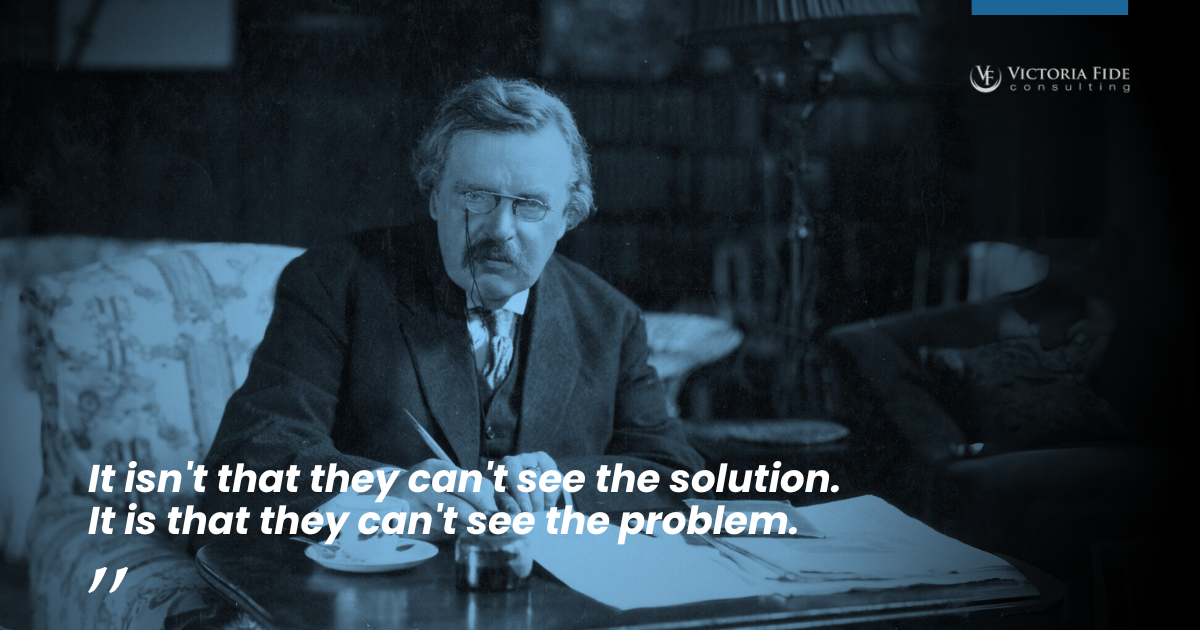
The Sage Wisdom series is produced by Victoria Fide Marketing with input and oversight from our leadership team and industry SMEs.
G.K. Chesterton (Gilbert Keith Chesterton) was a prolific English writer, essayist, and novelist who lived from 1874 to 1936. He is best known for his wide-ranging literary contributions, including a fiction series featuring the famous amateur detective character Father Brown, as well as thought-provoking essays and philosophical works. His writings, often characterized by incisive wit, challenged prevailing ideologies, and advocated for a humane and common-sense approach to societal issues, making him a prominent figure in the intellectual and cultural landscape of the early 20th century.
Chesterton, also crowned as the “prince of paradox,” is credited with the quote, “It isn’t that they can’t see the solution. It is that they can’t see the problem.” In today’s digital world, technology solutions are not hard to come by. Cloud computing platforms have revolutionized data storage and processing, offering scalable and cost-effective solutions for businesses of all sizes. Enterprise resource planning (ERP) software streamlines complex business operations by integrating various functions like finance, human resources, and supply chain management. Additionally, customer relationship management (CRM) systems enable companies to manage their interactions with customers and prospects more effectively. Moreover, artificial intelligence (AI) and machine learning technologies are taking the business world by storm with the potential to transform decision-making and predictive analytics.
There’s no shortage of technology solutions. The key to choosing the right one is to comprehend the underlying organizational issues you seek to address. This is why performing a Transformational Opportunities Assessment is essential before embarking on a digital transformation (DX) initiative. In this article, we will explore this critical step to identifying and understanding transformational opportunities, uncover strategies that address the dangerous technology-first mentality and prevent wasted money on cutting-edge technology solutions that fail to meet the organization’s specific needs.
Digital Transformation: More than Software Implementation
At its core, digital transformation (DX) transcends a mere adoption of technology; it represents a holistic metamorphosis of organizational structures and processes aiming to reposition businesses for sustained relevance and success. As a result, it is imperative for business leaders to avoid adopting a technology-first mentality. They must truly seek to understand their specific problem areas, the interconnectivity between departments, and the impact to human assets before moving forward with a technological solution.
According to International Association of IT Asset Managers, $30 billion is wasted on unused or underutilized software in the United States. Not only is it a waste of money and resources, but it often does not result in better business outcomes, landing the organization back in another cycle of expensive and ineffective DX projects with no hope of achieving a positive ROI.

Free PDF Download
In the rapidly changing digital landscape, more and more companies are desperately trying to keep up with the competition. Download “The 10 Biggest Mistakes Businesses Make in Digital Transformation” for free today to learn how to use DX to radically transform your business and gain an edge over your competitors.
To prevent wasted time, money, resources and frustrations, leaders should take Chesterton’s wisdom to heart and work to see the problem in full before looking for a solution. One way to accomplish that is by building a technological transformation plan that is based on the opportunities that have been identified.
Mapping Organizational Success
A transformational opportunities assessment will provide the organization with a thorough bird’s eye view of the organization, much like finding the “You Are Here” star on a mall directory. This assessment helps leaders see the problem, so they are better equipped to choose the right fit for transformative endeavors, paving the way for improved business outcomes, enhanced ROI, heightened efficiency, and a competitive market advantage.
There are two general areas for transformational opportunities: expansion opportunities and improvement opportunities. Let’s take a look at expansion opportunities.
Expansion
Whether it’s through product expansion, market expansion, channel expansion or geographical expansion, the Transformational Opportunities Assessment becomes the strategic compass to navigate these growth initiatives. By carefully evaluating the potential for expansion, organizations can align their resources and capabilities with market demands, ensuring a seamless and strategic journey toward broader horizons. This proactive approach not only mitigates risks associated with rapid growth but positions the organization to capitalize on emerging market trends, fostering sustainable success.
Improvement
Often when people think about digital transformation, it is through the lens of upgrading systems, automating processes, or adding new technologies. However, every organization has areas ripe for improvement, and digital transformation initiatives provide an opportunity to capitalize on them. By strategically addressing these improvement opportunities, businesses can elevate their operational maturity, streamline processes, reduce redundancies, and foster a culture of continuous improvement. The result is a more agile and responsive organization, capable of adapting to evolving market dynamics and gaining a competitive edge in an ever-evolving business landscape.
Transformation is not easy, but it doesn’t have to be impossible. Take control of your project’s success today and schedule a free 30-minute consultation to find out how Victoria Fide can equip you for transformational success.

Performing a Transformational Opportunities Assessment
A Transformational Opportunities Assessment is built from the results of the three specific activities in Victoria Fide’s Proven Process for Transformational Change.
The assessment will seek to answer:
- What is the organization’s readiness for change?
- Is the organization’s systems and infrastructure equipped to handle transformation?
- What key areas should be the focus of change?
Transformation Scope and Status Assessment
Before assessing transformation opportunities, it’s necessary to conduct an initial business and technology vision meeting with executives to determine their goals and objectives, the status of any current transformation activities, and what key areas to focus on during the opportunities assessment. This initial activity involves key stakeholders and provides a foundation for the transformational opportunities assessment.
Enterprise Process Review
Once the goals and objectives are clearly defined, interview subject matter experts and process owners to gather information regarding the high-level processes within the scoped process groups. During the enterprise process review, it’s necessary to document the business objective for the process, a high-level narrative of the process, and key problems or pain-points in the process. This documentation will provide a comprehensive foundation for informed decision-making during the entire transformational process.
Enterprise Architecture Review
Next, you must document the high-level technical architecture – such as the infrastructure, systems, and integrations – the current system health at a high-level, and any key policies. If this documentation does not already exist, you must conduct a series of discussions with IT staff and review any relevant artifacts to gather the necessary information. The availability and accuracy of this documentation will provide input to the organization’s operational maturity and readiness for change.
Transformational Opportunities Assessment
Finally, you can analyze the results of all three activities. This will include reviewing existing functionality obtained through customizations in the current systems, current custom applications, and manual processes.
With the combination of the company goals and objectives, the identified problems and pain-points, and the gaps in existing systems that do not meet goals and objectives, you will have the information needed to identify the highest value transformations. When assessing transformational opportunities, it’s important to consider the potential benefits and technology compatibility. If the projected ROI is high and the solution is compatible with technology, it is a high value opportunity. But if the projected ROI is slim and the technology is not a great fit, it will not be worth investing in a DX initiative.

See the Problem to Seek the Solution
In conclusion, G. K. Chesterton’s wisdom shows that true DX success begins with understanding the problem before seeking a solution. By prioritizing the critical first step of understanding problems over hasty technological solutions, we pave the way for genuine, transformational success. The Transformational Opportunities Assessment provides the foundation needed to grasp the intricacies of the issues before venturing into solutions. It does this by synthesizing insights from the Transformation Scope and Status Assessment, the Enterprise Process Review, and the Enterprise Architecture Review to form a cohesive strategy for pinpointing high-value transformational opportunities.
As you embark on your digital transformation journey, consider partnering with Victoria Fide. By embracing Chesterton’s philosophy, we ensure that your path to digital transformation is grounded in a thorough understanding of challenges and opportunities, making success not just a possibility but a high probability. Trust us to navigate the complexities and let Chesterton’s wisdom be your guide to a triumphant digital transformation.
Subscribe to our weekly LinkedIn Digital Transformation Success newsletter and get notified of each new edition.
